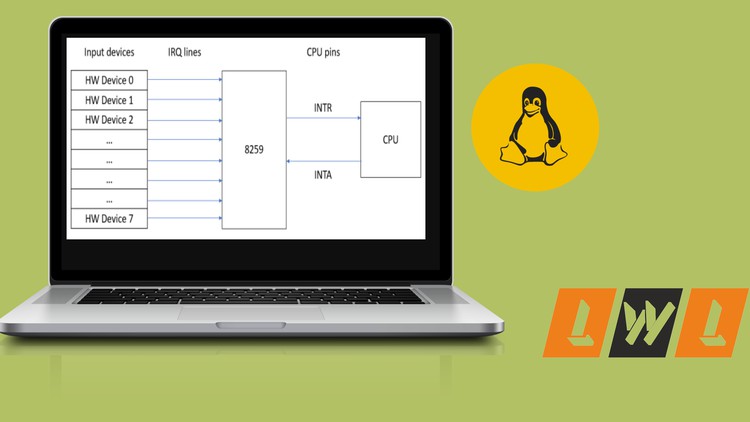Interrupts and Bottom Halves in Linux Kernel

Why take this course?
🌟 Unlock the Secrets of Interrupts and Bottom Halves in the Linux Kernel! 🚀
Course Title: Linux Kernel Programming - Interrupts and Bottom Halves
Headline: Dive Deep into the Linux Kernel's Core Mechanisms: Understanding Interrupts and Bottom Halves!
What You Will Learn from this Course 🎓
- Interrupts and Exceptions: Explore different types of interrupts and exceptions, including Level Triggered, Edge Triggered, Traps, and Faults.
- Programmable Interrupt Controller & Advanced Programmable Interrupt Controller (APIC): Gain insights into the IO APIC, Local APIC, and how they manage interrupts in x86 systems.
- CPU Information: Learn to extract detailed information about your x86 CPU using the CPUID instruction.
- Interrupt Handling and Statistics: Discover the process of handling interrupts, including interrupt sharing, return values, IRQ Affinity, and how to monitor interrupt activity within the kernel.
- Linux Drivers: Understand the workings of keyboard, mouse, ethernet drivers, and how they handle interrupts.
- Practical Exercises: Write a Keylogger in Linux Kernel that logs all typed characters legally and ethically for learning purposes.
- Enabling/Disabling Interrupts: Master the timing and implications of enabling and disabling interrupts within the kernel.
- Top and Bottom Halves: Delve into Threaded IRQs, Softirqs, Tasklets, and Workqueues, and understand the differences between them.
- Files and Utilities: Leverage files like
/proc/cpuinfo,/proc/interrupts,/proc/irq, and/proc/softirqsfor insightful information about the system's interrupt handling. - API's/Macros/Structures: Get hands-on experience with
request_irq,irq_handler_t,local_irq_enable, and other pivotal elements of kernel programming. - Commands: Master utilities like
watch,lspci, anddmesgto interact with the Linux Kernel's interrupt management system.
Course Structure Overview:
-
Interrupts and Exceptions:
- Types of Interrupts and Exception Handling
- Understanding the CPUID Instruction
-
Programmable Interrupt Controller (PIC) & Advanced Programmable Interrupt Controller (APIC):
- IO APIC, Local APIC Deep Dive
-
CPU Information:
- Leveraging CPU Features for Efficient Interrupt Handling
-
Interrupt Handling and Statistics:
- Best Practices in Kernel Interrupt Sharing
- Monitoring and Analyzing IRQ Activity
-
Linux Device Drivers:
- Real-world Examples with Keyboard, Mouse, and Ethernet Drivers
-
Practical Exercises:
- Implementing a Keylogger in the Kernel for Learning Purposes
-
Enabling/Disabling Interrupts:
- Timing Implications and Synchronization Techniques
-
Top and Bottom Halves:
- Threaded IRQs, Softirqs, Tasklets, and Workqueues Demystified
- Understanding the Differences Between softirqs, tasklets, and workqueues
-
Files and Utilities:
- Exploring Kernel-related Proc Filesystem Entries
-
API's/Macros/Structures:
- Deep Dive into
request_irq,irq_handler_t, Tasklets, Workqueues, and More
- Deep Dive into
-
Commands:
- Utilizing
watch,lspci, anddmesgfor Kernel Management
- Utilizing
Join us on this journey to master the Linux Kernel's interrupt handling mechanisms and become a kernel programming pro! 🤓 Enroll now to gain the skills that will set you apart in the realm of Linux Kernel Development.
Loading charts...